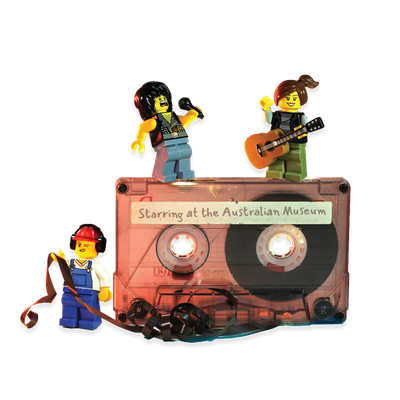Your search returned 12 results
By Page Type
By Tag
- All
- fish (966)
- blog (698)
- fishes of sydney harbour (400)
- First Nations (293)
- Blog (236)
- AMRI (169)
- archives (165)
- Aboriginal and Torres Strait Islander (135)
- Eureka Prizes (131)
- insect (126)
- Ichthyology (125)
- geoscience (109)
- minerals (102)
- climate change (98)
- podcast (94)
- Fish (91)
- Anthropology (89)
- International collections (80)
- Minerals Gallery (78)
- wildlife of sydney (78)
- Labridae (77)
- frog (73)
- gemstone (70)
- history (63)
- photography (63)
- staff (61)
- Mollusca (60)
- gem (59)
- Birds (58)
- education (57)
- Gems (56)
- Indonesia (56)
- AMplify (54)
- shark (54)
- people (53)
- exhibition (52)
- earth sciences (50)
- past exhibitions (50)
- Gobiidae (48)
- Pomacentridae (45)
- sustainability (45)
- Serranidae (44)
- science (43)
- lifelong learning (42)
- Earth and Environmental Science (41)
- Syngnathidae (41)
- Ancient Egypt (40)
- Bali (40)
- bird (40)
- dangerous australians (40)
-
Dinosaurs - Nanotyrannus lancensis
https://australian.museum/learn/dinosaurs/fact-sheets/nanotyrannus-lancensis/Nanotyrannus means ‘pygmy or dwarf tyrant’, alluding to its small size compared to other members of its presumed subfamily, Tyrannosaurinae. Lancensis refers to the ‘Lance Formation’ in Montana, where the skull was found in 1942 by American palaeontologist David H Dunkle.
-
Dinosaurs - Proceratosaurus bradleyi
https://australian.museum/learn/dinosaurs/fact-sheets/proceratosaurus-bradleyi/Proceratosaurus means ‘lizard before Ceratosaurus' in Greek, and bradleyi refers to Mr F Lewis Bradley, who discovered the first specimen in the early 1900s. This small early tyrannosaur had unusually enlarged nostrils and a head crest.
-
Dinosaurs - Appalachiosaurus montgomeriensis
https://australian.museum/learn/dinosaurs/fact-sheets/appalachiosaurus-montgomeriensis/Appalachiosaurus montgomeriensis is the first and most complete theropod tyrannosaur known from the eastern USA. It is smaller than its relatives Albertosaurus and Gorgosaurus.
-
Dinosaurs - Leaellynasaura amicagraphica
https://australian.museum/learn/dinosaurs/fact-sheets/leaellynasaura-amicagraphica/Leaellynasaura amicagraphica was a tiny ornithopod from the Early Cretaceous of Victoria (perhaps a juvenile because of its small size).
-
Dinosaur - Mamenchisaurus youngi
https://australian.museum/learn/dinosaurs/fact-sheets/mamenchisaurus-youngi/Mamenchisaurus youngi was a gigantic herbivore that lived around 150 million years ago and had one of the longest necks of all known dinosaurs.
-
Lightning Beast - Ornithopod dinosaur
https://australian.museum/learn/dinosaurs/fact-sheets/fulgurotherium-australe/Fulgurotherium australe was a small ornithopod dinosaur from the Early Cretaceous of Australia. Fulgurotherium, known from Lightning Ridge in New South Wales and perhaps from Victoria, was one of the first Australian dinosaurs to be scientifically described.
-
Dinosaur - Qantassaurus intrepidus
https://australian.museum/learn/dinosaurs/fact-sheets/qantassaurus-intrepidus/Qantassaurus intrepidus, named after the Australian airline Qantas, was a small ornithopod from the Early Cretaceous of Victoria.
-
Dinosaur - Xiongguanlong baimoensis
https://australian.museum/learn/dinosaurs/fact-sheets/xiongguanlong-baimoensis/Xiongguanlong means ‘dragon from Xiong Guan’ in Mandarin, and baimoensis is from the Mandarin for ‘white ghost’, referring to the ‘White Ghost Castle’ formation near the fossil site. This meat-eater was an early tyrannosaur that grew to about 5 metres long.
-
Dinosaur - Guanlong wucaii
https://australian.museum/learn/dinosaurs/fact-sheets/guanlong-wucaii/Named from the Chinese words guan, meaning 'crown', and long, meaning 'dragon', in reference to its flashy head-crest, the most elaborate of any known theropod dinosaur.
-
Dinosaur - Eotyrannus lengi
https://australian.museum/learn/dinosaurs/fact-sheets/eotyrannus-lengi/The relatively small tyrannosaur Eotyrannus lived about 60 million years before its more famous relative Tyrannosaurus rex.
-
Find out more
Tails from the Coasts
Special exhibition
On now![]()
-
Find out more
Burra
Permanent kids learning space
10am - 4.30pm![]()
-
Discover more
RELICS
Special Exhibition
Opens 16 August 2025![]()
-
Discover more
Minerals
Permanent exhibition
Open daily![]()





